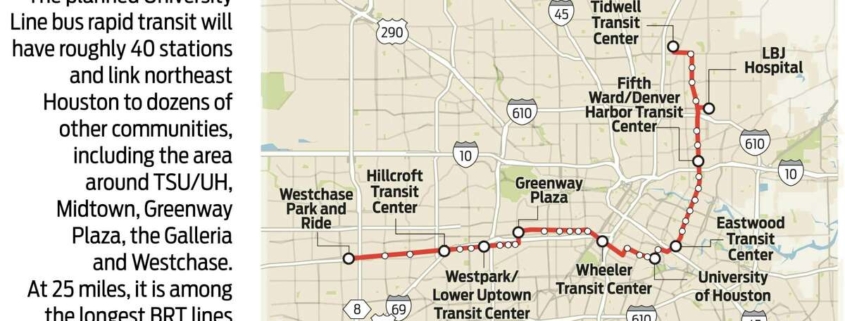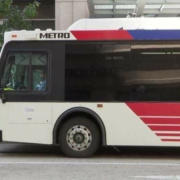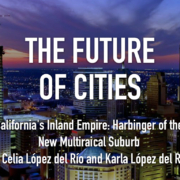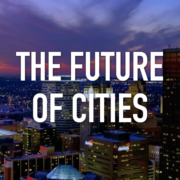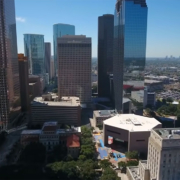Metro Needs to Rethink the University Line
In 2019 Metro convinced 68% of voters to support their $7.5B MetroNEXT plan, which I also cautiously supported. Since then we’ve had a global pandemic and the rise of remote work along with a transit ridership crash and anemic recovery, so Metro is stepping back to rethink everything…
Just kidding! Nope, they’re plowing right ahead like nothing happened in the last three years, currently focused on the Universities Line.
I have to give them credit for switching it from crazy-expensive light rail to just plain expensive bus rapid transit (BRT) for the referendum, but now the ugly rubber is meeting the pothole-patched road as they transition from nice lines on a map to actual detailed planning, and a hornet’s nest of opposition is stirring up:
“The experience of Metro projects is that they carry the same number of riders,” said Neal Meyer, 56, a critic of the agency who has written skeptically of transit plans for years. “They’re not worth it.” …
“I really don’t know if there is any real strategy that can be implemented that will attract more people to take transit,” he said. “For the whole project and all the mega-projects that they want us to pay for, I just have serious doubts.”
It is the same skepticism raised when Metro expanded its light rail lines. Extending the Red Line trains north and building the Green and Purple Lines took Metro more than six years and $2.1 billion. Along the Purple Line, officials at the time they applied for $450 million in federal funds estimated the route would carry 28,800 riders daily by 2030. Its highest average daily ridership, in October 2019, was 7,581. Currently it is about 3,550. …
Even where faster, more reliable transit is welcomed, however, the project’s specifics will weigh heavily on neighbors who have seen Metro’s light rail lines gobble homes and green space, cripple businesses through years of street-choking construction and frustrate residents living in a work zone.
Plans for the University Line rely on dedicated bus lanes past Texas Southern University, along Ennis from Elgin to Blodgett through Third Ward. Now a cracked and uneven four-lane street, renderings prepared by Metro show Ennis at Wheeler with six lanes — including the two bus lanes — and wide sidewalks with painted crosswalks.
What it fails to show is where that extra space is going to come from.
“It is pretty, but it is not accurate,” said state Rep. Jolanda Jones, a Houston Democrat whose family has been in the area for decades. “They are going to take homes and that is not going to happen. Not if I have anything to do with it.” …
Other neighborhoods have similar concerns, though the likelihood of losing homes is more concentrated in certain areas, including Third Ward and the East End. Along Richmond, business and property owners who lived through the fight over light rail along the avenue 15 years ago are mobilizing again. Daphne Scarborough, a long-time Metro critic who fought the light rail plans, said the buses are not much different and will cause problems for traffic where Richmond is narrowed to one lane east of Shepherd.
It’s that last point on Richmond getting narrowed to one lane each direction that really concerns me. Given the constraints and bottlenecks on Westheimer, W. Alabama, and Bissonet, Richmond is the only surface street with significant east-west capacity from Upper Kirby to Montrose and Midtown – it absolutely needs to keep a *minimum* of two general traffic lanes each direction all the way through. As more people and businesses find out about the one-lane plan, I expect opposition to continue to mount.
And yet the promise of the University Line hasn’t swayed its consistent critics. The Chronicle’s Dug Begley reported last week that many transit opponents are raising a stink that Metro system’s relatively modest ridership has failed to justify the project’s high cost. They worry that construction of the University Line will snarl traffic, invite unwelcome development and cripple local businesses.
What neither Metro nor the Chronicle mention is that at a 10mph average speed this route will take *more than two hours* to ride end-to-end over 25 miles and 40 stops! I base that on the Post Oak Silver BRT line taking a half-hour to go 5 miles with 10 stops, so 4-5x that. Will people really ride that? And is it much time savings vs. existing bus routes?
What’s my suggestion? Given the disruption and cost involved, as well as changes around remote work and autonomous Ubers, it would be better for the University Line to start as an express Quickline service *without* dedicated lanes to see if it can build ridership before spending $1.5 billion (easily $2 billion with inflation) on a BRT. Frequent Quickline service would be a relatively easy, cheap test without the disruption and lost lanes. It would also allow experimentation with the exact route and stops to find the best mix *before* sealing it in concrete. If it proves to be popular with growing ridership justifying more capacity, *then* let’s revisit the possibility of upgrading it to BRT. By then we’ll also have a lot more clarity on the future of remote work and autonomous taxis so we don’t build another underutilized white elephant just like the Green, Purple, and Silver Lines. How about it Metro?
This piece first appeared at Houston Strategies.
Tory Gattis is a Founding Senior Fellow with the Urban Reform Institute (formerly Center for Opportunity Urbanism) and co-authored the original study with noted urbanist Joel Kotkin and others, creating a city philosophy around upward social mobility for all citizens as an alternative to the popular smart growth, new urbanism, and creative class movements. He is also an editor of the Houston Strategies blog.

